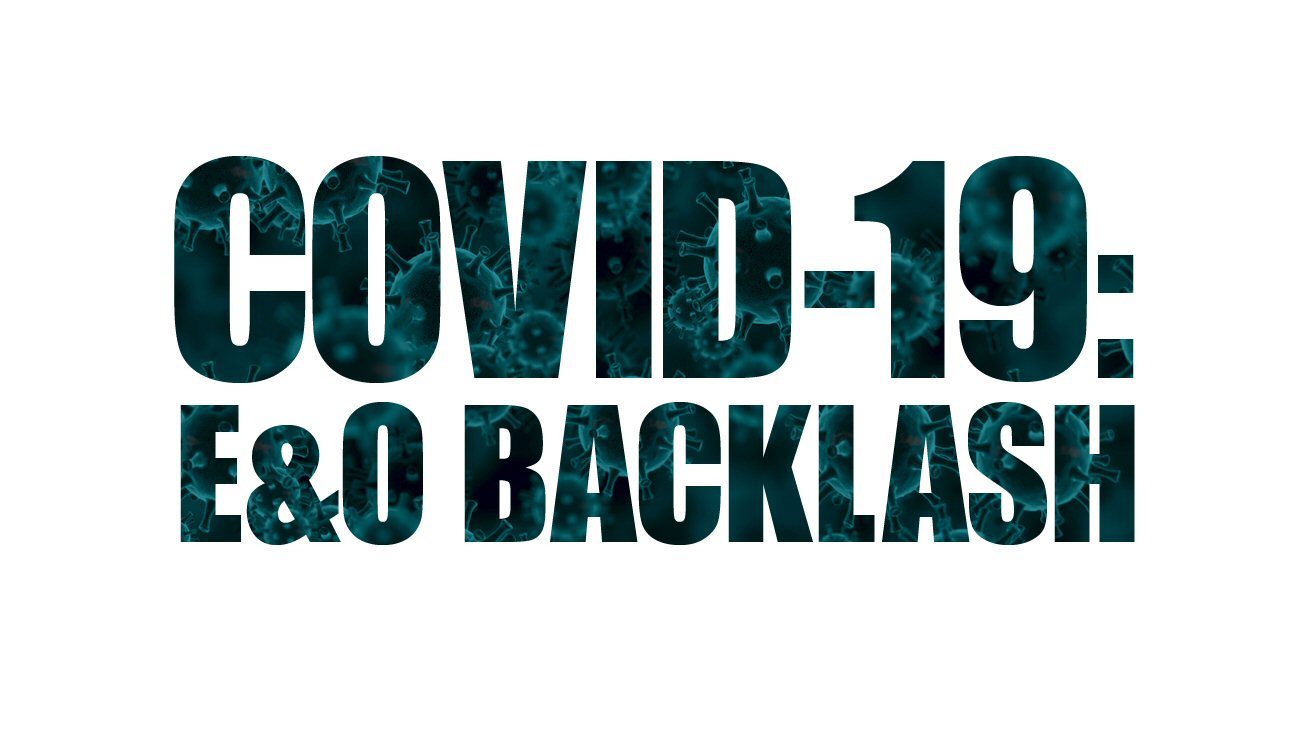COVID-19: E&O BACKLASH
With employees working from home, exposures abound … here’s what agency owners need to know
By Mary LaPorte, CPCU, AINS, CIC, CPIA, LIC
Pandemic.
Who knew? Until COVID-19 appeared on the scene, no one gave much thought to pandemics. They were something that happened in other countries or in “doomsday” movies. We never considered how a pandemic could affect our personal lives, let alone our agencies.
When the coronavirus pandemic first became a concern in the United States, agency owners needed to make decisions quickly to protect their employees and the public. Even in states where agencies were designated “essential” businesses, most still closed their doors to the public. Debbie Platt, vice president of R.V. Johnson Insurance in Stuart, Florida, explains how they handled the situation: “We let our employees choose whether to continue to come in or to work from home,” she says. “As a result, we have about 50% of our staff in the office.”
During this unprecedented time of state-mandated business shutdowns and stay-at-home orders, you cannot afford to risk errors and omissions claims against your agency. An ounce of prevention now could be worth a pound of E&O cure in the future.
“We sent almost everyone home,” says Wendy Light, commercial department manager at Peabody Insurance in Fenton, Michigan. “Our doors are locked, but we kept our receptionists in the office to route calls and maintain our usual standard of having a friendly voice to greet customers. Also, our agency principals are in the office every day, attending to details.”
During this unprecedented time of state-mandated business shutdowns and stay-at-home orders, you cannot afford to risk errors and omissions (E&O) claims against your agency. An ounce of prevention now could be worth a pound of E&O cure in the future.
When it comes to E&O exposures, agency owners and managers may think they have bigger fish to fry right now. The truth is, agencies have never been more vulnerable. Taking shortcuts, working with fewer resources, trying to concentrate amid distractions, mishandling coverage placements, or simply overlooking steps in a process can increase your E&O vulnerability.
The COVID-19 pandemic already is taking a financial toll on businesses, including insurance agencies. When the stay-at-home restrictions are lifted, your employees will be returning to a changed office. Revenue likely will be down because of declining sales. Premiums based on sales or payroll will be lower. And sadly, some of your commercial accounts may not survive, and those accounts may be difficult to replace. The last thing your agency needs is an E&O claim or, worse, a string of them.
Communication is key
Clear, consistent communication is more important than ever as employees adjust to working remotely. Consider videoconferencing with your team every morning so employees can share concerns and troubleshoot solutions. Use email and/or instant messaging to communicate with team members throughout the day. Employees may be facing new situations or questions from clients that are emerging from the pandemic. Help your employees gain confidence so they can educate clients about relevant coverage concerns.
Many [employees] are working from laptops instead of the workstations with dual monitors and full-sized keyboards to which they are accustomed. Therein lies an E&O exposure.
David Fritz, CEO of TRICOR Insurance in Lancaster, Wisconsin, agrees that communication is key in this time of pandemic. “We are communicating with our staff in several ways,” he explains. “Each day after our division leaders meeting, we send an email to all employees with daily highlights. We use videos on an unlisted YouTube channel to provide daily COVID-19 updates and send them to employees by email. We also use GoToMeeting videoconferencing to connect teams and departments.”
Employees who are not accustomed to working from home may find it challenging to maintain concentration and follow through on tasks. Use reports, dashboards, or other tools to ensure that employees are staying on task and not becoming overwhelmed. Look for indicators such as a backlog of overdue follow-ups or a high volume of messages in an employee’s electronic mailbox. For some employees, a backlog may result from inadequate resources at home, which can cause the employee to take longer to complete each task. Others may be trying to work in a home environment where distractions or other issues interfere with productivity. Find ways to offer these employees assistance and support. If your agency has an employee assistance program, be sure your employees are aware of this resource.
Home workstations
Some employees have been working full time off site and therefore are well equipped to handle a stay-at-home directive. Others have worked at home only occasionally and may not have all the tools they need to do their best work. Many are working from laptops instead of the workstations with dual monitors and full-sized keyboards to which they are accustomed.
The strongest defense an agency can mount in the event of an E&O allegation is thorough and accurate documentation. After every phone conversation, the employee should enter into the agency management system a note or activity that summarizes the discussion.
Some carriers also are extending coverage automatically to vehicles used to make deliveries. The E&O trap may come later when carriers remove the “free” coverage they have provided during the pandemic.
Therein lies an E&O exposure. Among other adjustments employees must make when navigating the office-to-home transition, a major challenge is maintaining accuracy and consistency; this is compounded when employees are trying to make do with home equipment. Providing dual monitors and full-sized keyboards is a small investment in reducing the potential for errors and maintaining an efficient workflow. At R.V. Johnson, employees took their entire workstations home with them, including computer, monitors, keyboard, and headset. “We recognized that they would be more productive using the equipment they were most familiar with,” Platt explains.
For the employees of Peabody Insurance, the transition was “fast and easy,” says Light. “Our employees already had agency-owned laptops and the ability to connect from home. We immediately purchased additional monitors and earbuds for their phones because we knew that would help them work more efficiently.”
Given the increasing frequency and variety of cyber attacks, agencies should use a virtual private network (VPN) to protect all connections with remote employees’ computers. All personally identifiable data and other protected information should be encrypted before it is emailed. If you are not already using multi-factor authentication, now may be the time to consider it; the pandemic is spawning a growing volume of online scams. Remind employees to be alert for phishing emails and to refrain from opening suspicious messages, attachments, or links. All suspicious emails should be reported to agency management.
If employees are using personal computers or laptops to connect to the agency’s management system, they should not download new apps or use social media. They should sign off the agency system when leaving their work area to prevent others in the household from accessing protected information. Periodically review your agency’s security and privacy requirements with employees.
“The time and resources spent to digitize our agency was an investment that needed to happen,” Fritz asserts. “The need to rapidly move employees from office to home was a true ‘stress test’ of the technology we had implemented and the staff mobility we had been planning for many years. I am really proud of our staff for their flexibility and how they stood up to this challenge.”
Documentation = defense
The strongest defense an agency can mount in the event of an E&O allegation is thorough and accurate documentation. After every phone conversation, the employee should enter into the agency management system a note or activity that summarizes the discussion.
Digital VoIP telephone systems allow agencies to seamlessly transfer calls to employees who are working from home. Most employees are answering those calls on their mobile phones. Using a headset or earbuds frees the employee’s hands to write down or enter information in the management system while speaking on the phone. This is critical when documenting conversations with clients or others.
When the dust settles and our agencies move into the new normal, we all hope we can look back with satisfaction and pride. We did what needed to be done. Our people stepped up to the challenge.
Documentation also can be in the form of email messages. Employees should promptly attach emails to the management system where they will be stored in an unchangeable format.
If anyone is likely to go stir-crazy during this time, it is probably producers. Most are extremely social, and staying at home without people contact is very much outside their box. This is a good time for producers who have not felt comfortable using digital resources to strengthen their skills in this area. Producers who have stronger digital marketing skills could use this downtime to mentor others and thus help to create a stronger, more well-rounded sales force.
Of course, producers should pick up the phone and keep connecting with existing clients and prospects, and they should follow the same documentation steps as service employees use.
Some agencies may find that, after reaching out to their clients and prospects, producers still have time on their hands, while CSRs and account managers are struggling to keep up with client requests and general processing. This is a time for “all hands on deck.” Producers can support service staff with upcoming renewals by updating information and schedules and obtaining renewal quotes.
 COVID-19 coverage concerns
COVID-19 coverage concerns
Many client businesses have been deemed “nonessential” and may have no source of income during this time. Even “essential” businesses may be earning substantially less income because of COVID-19 restrictions. Such clients may turn to their insurance policies for financial relief. There are ongoing arguments as to whether insurance carriers should be required to pay business income losses resulting from the pandemic, even though the typical policy does not cover such situations. Explain to clients that for business income coverage to apply, the interruption of business operations must result from a covered loss under the policy. If a client wants to make a claim, submit the claim to the carrier. It is up to the carrier to deny coverage, not you. Never promise or deny coverage. And resist the temptation to speculate as to how our government will handle this situation.
Be diligent about reporting incidents under claims-made forms to ensure that coverage will be triggered as required by the contract.
With people driving less, some clients are asking agents to remove vehicles from their policies or put them in “layup” while retaining only comprehensive coverage. This is happening in both personal and commercial lines. An E&O danger arises when clients forget they removed coverage and start to drive the laid-up vehicle, which in many jurisdictions means they will not have liability coverage in the event of an at-fault accident. Clearly communicate to clients in writing the need to request that liability coverage be restored before they drive the vehicle.
“We’re finding that customers have more free time on their hands and are attempting to either read their policy or find ways to reduce their premium,” says Platt. “This has resulted in more in-depth conversations than usual [with our employees], which is taking up more of everyone’s time.” It might be tempting for employees to try to rush through a lot of “what if” questions, especially when they are busy. Caution them to be clear with their answers while not overstating what the policy covers. Documentation should describe the questions asked as well as the responses given.
Some auto insurers are offering rate reductions for a designated period or a flat refund per vehicle. Some carriers also are extending coverage automatically to vehicles used to make deliveries. The E&O trap may come later when carriers remove the “free” coverage they have provided during the pandemic. To minimize E&O exposure, educate clients now. Explain that using a vehicle to make deliveries was never covered in the past and remind clients that they need to specifically request this coverage in the future if they continue to make deliveries with their vehicles.
Coverage issues likely will continue to emerge during the COVID-19 crisis. Stay on top of new developments, and educate your employees to ensure they will be well informed as they interact with clients. “We are working closely with our insurance carrier partners and are able to get daily updates,” Fritz remarks. “Our leadership team is meeting virtually with their extended teams to make sure we’re keeping staff updated on current questions from clients, how we can help our clients digest information, and how it applies to their insurance and risk management program.”
The devil is in the details
For most agencies, the COVID-19 pandemic has created new territory. When establishing a remote workforce, consider these important points to minimize the potential for E&O claims:
- Incoming mail. How will it be distributed to at-home employees? If your agency was not already using front-end scanning, this is the time to start so that documents can be forwarded electronically. Who will retrieve paper mail, then scan and distribute it as needed? This includes overnight mail such as FedEx and UPS.
- Outgoing mail. If you send outgoing mail, how will this be done by remote employees? Examples are evidence of coverage documents and auto IDs. Do remote workers have printers that will let them mail items themselves? Can they queue documents to print in the office? Can they send a PDF to be printed in the office and then mailed? Who is responsible for retrieving and mailing the printed document? Do your documentation standards require each step of the process to be recorded in your management system?
- Some documents must be signed by the agency. In the case of bonds, you may need to affix a seal. How will these documents then be sent to the client?
- Policies and endorsements. These can be sent digitally to the client. Before doing so, an employee should obtain a signed authorization form from the client. Remind employees to obtain written consent and ensure that the authorization form is easily accessible.
- Payments received by mail. Who will retrieve them, forward them to the carrier, sweep them, or make deposits?
- Use caution if you place a drop box for payments at your office. The agency should not accept overdue payments without checking with the carrier to ensure that there is no coverage lapse. If you do use a drop box for this purpose, post a clear statement that leaving a payment in the box does not guarantee continuation of coverage. Because many carriers are offering extended grace periods during this time, employees should stay up to date on each carrier’s instructions.
- Carefully check renewals. Some carriers may attach new exclusionary endorsements or remove business income coverage because of COVID-19 uncertainties. Identify these situations so you can offer options to clients.
When the dust settles and our agencies move into the new normal, we all hope we can look back with satisfaction and pride. We did what needed to be done. Our people stepped up to the challenge. We built stronger relationships with clients. We are moving forward and have become stronger agencies because of what we endured together.
Don’t let that vision be shattered by a preventable E&O claim. Remind employees that the agency is more vulnerable than ever to E&O claims and encourage them to keep their guard up.
As World War II pioneer aviator General Jimmy Doolittle famously said: “One trouble with Americans is that we are fixers rather than preventers.” Let’s all make sure we are being good preventers right now.
 The author
The author
Mary LaPorte, CPCU, AINS, CIC, CPIA, LIC, is an independent agency consultant and trainer. In more than 30 years with a major independent agency in the Midwest, she held management positions in personal lines, claims, surplus lines, and errors and omissions. Mary has extensive experience with hiring, supervision, workflow, and agency acquisition issues.






